LG 29EA93 Ultrawide Display - Rev. 1.09
by Chris Heinonen on December 11, 2012 1:20 AM ESTLG 29EA93—Color Quality and Color Gamut
Out of the box, there is no sRGB mode for the LG 29EA93 to use, so I went with the Standard mode for the default testing. As always, I try to aim for a D65 white point, 2.2 gamma, and 200 nits of light output. All measurements are done using ColorEyes Display Pro, and using a NIST certified i1Pro spectrometer.
Just as expected, the 29EA93 is nothing to write home about straight out of the box. The dE average is just over 7, and the white error is very high as well. Without a pre-calibrated preset this is what I’d expect to see and so this isn’t really a surprise at all.
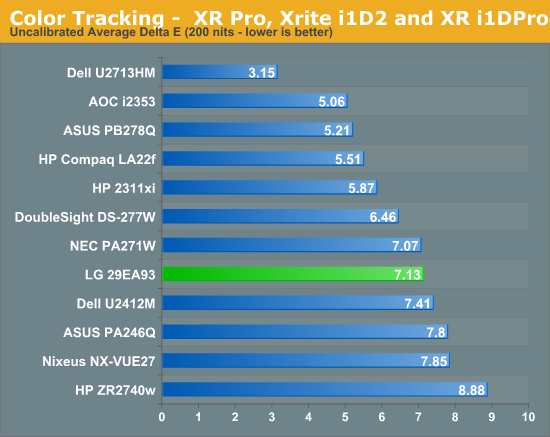
After a calibration, the LA 29EA93 fares much better. The average dE drops to a very respectable 1.61, and has a very low median dE of 1.33 as well. The main errors that are present are those that are hard for all displays to reproduce, such as certain blues, so this is a very nice calibrated result in the end for the LG.

When set to 100 nits that is more likely to be used for print media applications, the 29EA93 continues to have very nice calibrated results. The grayscale is nice and neutral, the colors are mostly accurate, and the resulting image is very nice on screen. Once calibrated the, LG 29EA93 produces an image that can keep up with the other IPS monitors out there.
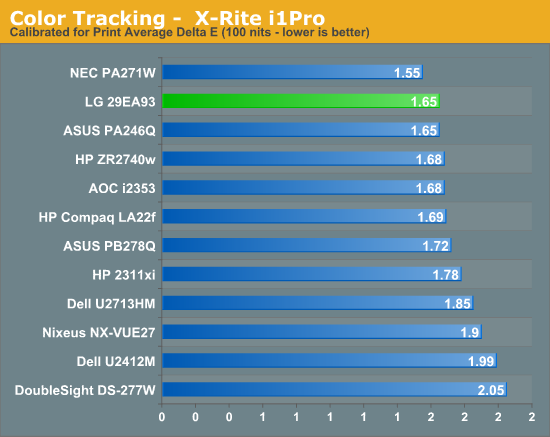
The one area that is does fall a bit short is in color gamut. It only covers 74% of the AdobeRGB gamut, which leaves it just a little short of the whole sRGB gamut. This little bit might not matter much in regular use, but it might matter more to those that are considering using it for color critical work.
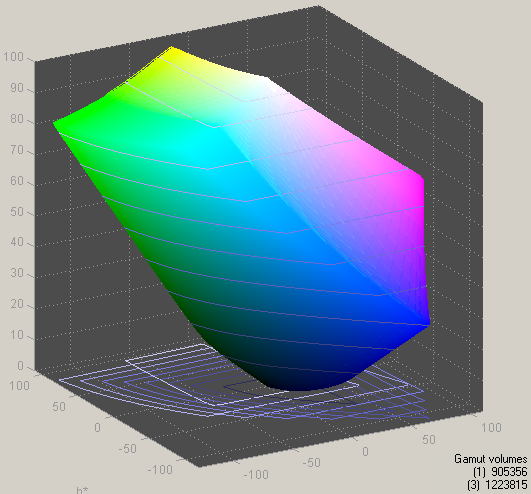
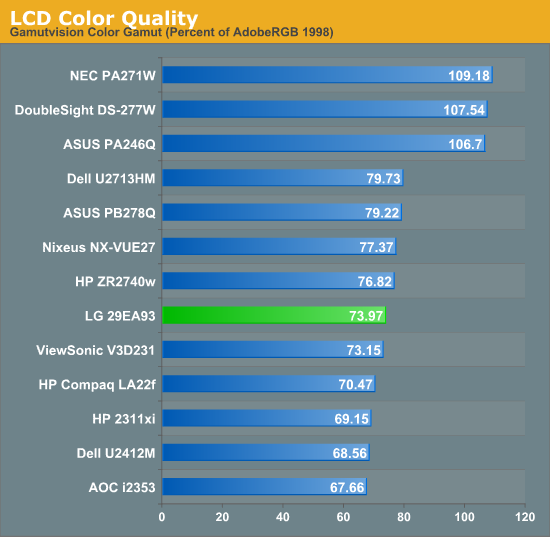


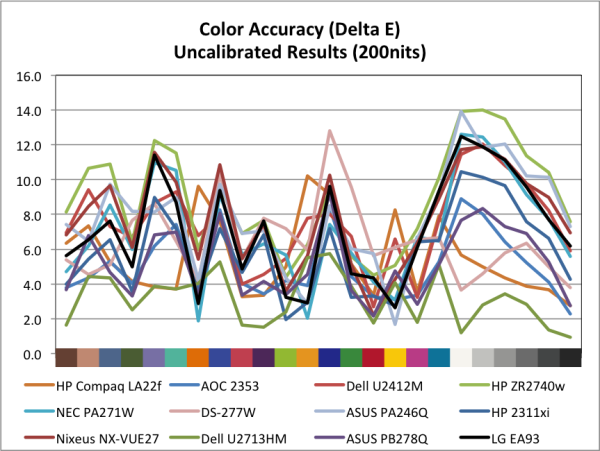
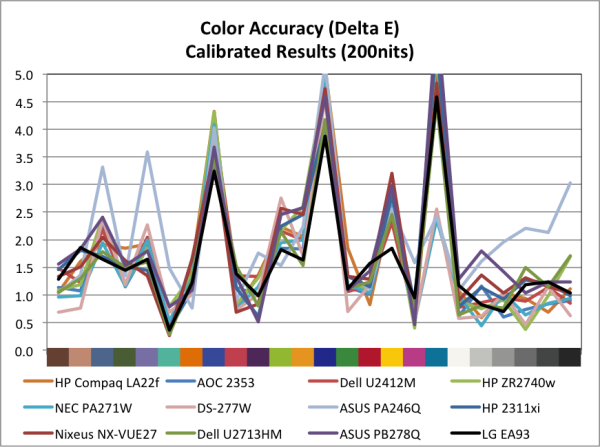
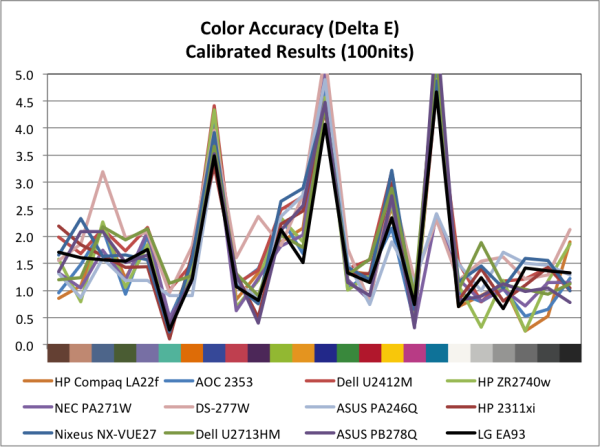








90 Comments
View All Comments
markstock - Tuesday, December 11, 2012 - link
AFAIK, analog VGA is limited to 2048x1536; hence no DB-15 connector.cheinonen - Tuesday, December 11, 2012 - link
Even then most higher resolution 27" and 30" displays still include one for backup, just like they also include HDMI 1.3 ports that don't support resolutions beyond 1080p. The lack of it isn't a large negative to me, as that cuts down costs for something few people use now, but I'm sure some people would want to know.TypeS - Tuesday, December 11, 2012 - link
This LG display seems to be very narrowly targeted at just film buffs, hence its size and panel type. This really would only be nice for films that stay in the ultra-wide cinematic aspect ratio.Elsewhere you've got TV shows that are full16:9, cheap direct-to-dvd/bluray releases that are 16:9 and films like the Dark Knight and Skyfall that have scenes in IMAX that will go 16:9. In all these cases you'll get vertical letter boxing. Just my own conclusion here, but horizontal letter boxing is less intrusive than black bars on the side.
I suppose there could be some productive benefits to this, view 3 pages side by side? Or producing network diagrams and other visuals like those.
Still seems a pretty niche target audience for this monitor. Wouldn't be a good trend to start with TVs either unless everyone dropped filming in 16:9.
radbeard - Tuesday, December 11, 2012 - link
i think its narrowly targeted at office productivity buffs.peterfares - Wednesday, December 12, 2012 - link
Taller screens are better for office work.James_Edge - Tuesday, December 11, 2012 - link
Cast you mind back to the old days, what aspect did people love for work, 4:3? 16:10, no, it was 5:4 aspect, like 1280x1024, this monitor as well as being great for movies lets you take advantage of the Windows 7/8 feature to dock two Windows on the screen side by side, and on this 2560x1080 screen that is a pair of 1280x1080 windows, 5:4 dual screen is back baby and you only need a single monitor to do it! :DTegiriNenashi - Tuesday, December 11, 2012 - link
A book with landscape pages, what are you guys smoking?GullLars - Wednesday, December 12, 2012 - link
Why not use something close to Phi as the convention for aspect ratio? 16:10 (1.600) is fairly close to 1.618. 16:9 is 1.777 and is going the wrong direction with respect to what feel natural to watch and work with.Phi also works nicely as an aspect ratio if you flip a screen into portrait mode, since it maps well to A4 (1.414) with window scroll bars and utilities.
Most web pages, like AnandTech, also only uses 600-1000 pixels in the width, so wider screens as at the relevant resolutions makes no sense for browsing the web. Again, protrait mode for 1080P and 1200P works well on the web, and also many other productivity tasks.
philipma1957 - Wednesday, December 12, 2012 - link
.263 dot pitch means i can see the grid when reading print on a white screen. so this would work for movies only. I have funky eyesight due to implants.left eye sees 20-10 .
right eye sees 20-80.
so if dot ptich is not small enough the 20-10 eye will see the grid lay out.
so get a 27 inch 1440p screen with smaller dot pitch no go the print is too small on certain websites and scales like crap.
I have found a 21 inch or 22 inch 1080 p looks best for print.
comomolo - Wednesday, December 12, 2012 - link
I don't buy the reasoning about movie formats. Who watches movies sitting at their desktop? Who would use such a small display to watch movies from the sofa?The transition from 16:10 to 16:9 only makes sense because panels are cheaper when they get smaller. It has nothing to do with movies and HDTV.
This monitor makes sense only in the office, for productivity, but it's absurdly expensive for that.
Either it becomes extremely cheap or I give it no more than one year in the market. At most.
Just as a sidenote: in Europe Philips introduced some time ago LCD TVs with a 21:9 aspect ratio. Nowhere to be found today.